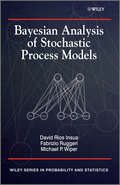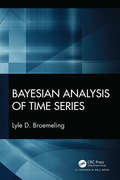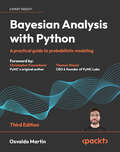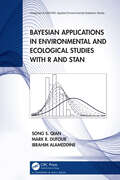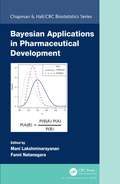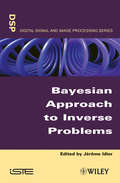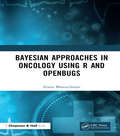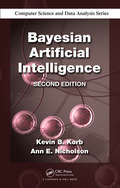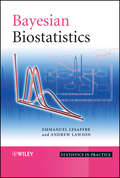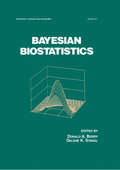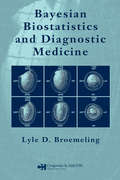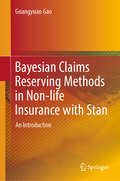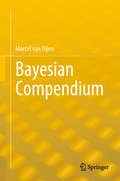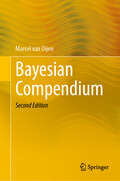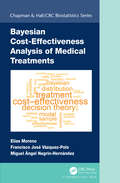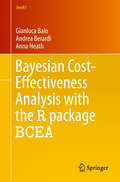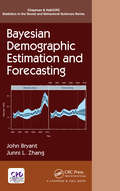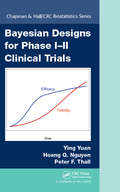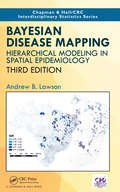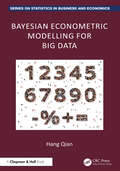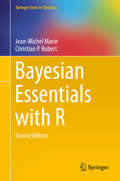- Table View
- List View
Bayesian Analysis of Stochastic Process Models
by Fabrizio Ruggeri David Insua Mike WiperBayesian analysis of complex models based on stochastic processes has in recent years become a growing area. This book provides a unified treatment of Bayesian analysis of models based on stochastic processes, covering the main classes of stochastic processing including modeling, computational, inference, forecasting, decision making and important applied models.Key features:Explores Bayesian analysis of models based on stochastic processes, providing a unified treatment. Provides a thorough introduction for research students. Computational tools to deal with complex problems are illustrated along with real life case studies Looks at inference, prediction and decision making. Researchers, graduate and advanced undergraduate students interested in stochastic processes in fields such as statistics, operations research (OR), engineering, finance, economics, computer science and Bayesian analysis will benefit from reading this book. With numerous applications included, practitioners of OR, stochastic modelling and applied statistics will also find this book useful.
Bayesian Analysis of Time Series
by Lyle D. BroemelingIn many branches of science relevant observations are taken sequentially over time. Bayesian Analysis of Time Series discusses how to use models that explain the probabilistic characteristics of these time series and then utilizes the Bayesian approach to make inferences about their parameters. This is done by taking the prior information and via Bayes theorem implementing Bayesian inferences of estimation, testing hypotheses, and prediction. The methods are demonstrated using both R and WinBUGS. The R package is primarily used to generate observations from a given time series model, while the WinBUGS packages allows one to perform a posterior analysis that provides a way to determine the characteristic of the posterior distribution of the unknown parameters. <P><P> Features <li>Presents a comprehensive introduction to the Bayesian analysis of time series. <li>Gives many examples over a wide variety of fields including biology, agriculture, business, economics, sociology, and astronomy. <li>Contains numerous exercises at the end of each chapter many of which use R and WinBUGS. <li>Can be used in graduate courses in statistics and biostatistics, but is also appropriate for researchers, practitioners and consulting statisticians. <P><P>About the author <P><P>Lyle D. Broemeling, Ph.D., is Director of Broemeling and Associates Inc., and is a consulting biostatistician. He has been involved with academic health science centers for about 20 years and has taught and been a consultant at the University of Texas Medical Branch in Galveston, The University of Texas MD Anderson Cancer Center and the University of Texas School of Public Health. His main interest is in developing Bayesian methods for use in medical and biological problems and in authoring textbooks in statistics. His previous books for Chapman & Hall/CRC include Bayesian Biostatistics and Diagnostic Medicine, and Bayesian Methods for Agreement.
Bayesian Analysis with Python: A practical guide to probabilistic modeling
by Osvaldo MartinLearn the fundamentals of Bayesian modeling using state-of-the-art Python libraries, such as PyMC, ArviZ, Bambi, and more, guided by an experienced Bayesian modeler who contributes to these librariesKey FeaturesConduct Bayesian data analysis with step-by-step guidanceGain insight into a modern, practical, and computational approach to Bayesian statistical modelingEnhance your learning with best practices through sample problems and practice exercisesPurchase of the print or Kindle book includes a free PDF eBook.Book DescriptionThe third edition of Bayesian Analysis with Python serves as an introduction to the main concepts of applied Bayesian modeling using PyMC, a state-of-the-art probabilistic programming library, and other libraries that support and facilitate modeling like ArviZ, for exploratory analysis of Bayesian models; Bambi, for flexible and easy hierarchical linear modeling; PreliZ, for prior elicitation; PyMC-BART, for flexible non-parametric regression; and Kulprit, for variable selection. In this updated edition, a brief and conceptual introduction to probability theory enhances your learning journey by introducing new topics like Bayesian additive regression trees (BART), featuring updated examples. Refined explanations, informed by feedback and experience from previous editions, underscore the book's emphasis on Bayesian statistics. You will explore various models, including hierarchical models, generalized linear models for regression and classification, mixture models, Gaussian processes, and BART, using synthetic and real datasets. By the end of this book, you will possess a functional understanding of probabilistic modeling, enabling you to design and implement Bayesian models for your data science challenges. You'll be well-prepared to delve into more advanced material or specialized statistical modeling if the need arises.What you will learnBuild probabilistic models using PyMC and BambiAnalyze and interpret probabilistic models with ArviZAcquire the skills to sanity-check models and modify them if necessaryBuild better models with prior and posterior predictive checksLearn the advantages and caveats of hierarchical modelsCompare models and choose between alternative onesInterpret results and apply your knowledge to real-world problemsExplore common models from a unified probabilistic perspectiveApply the Bayesian framework's flexibility for probabilistic thinkingWho this book is forIf you are a student, data scientist, researcher, or developer looking to get started with Bayesian data analysis and probabilistic programming, this book is for you. The book is introductory, so no previous statistical knowledge is required, although some experience in using Python and scientific libraries like NumPy is expected.
Bayesian Analysis with R for Drug Development: Concepts, Algorithms, and Case Studies (Chapman & Hall/CRC Biostatistics Series)
by Harry Yang Steven NovickDrug development is an iterative process. The recent publications of regulatory guidelines further entail a lifecycle approach. Blending data from disparate sources, the Bayesian approach provides a flexible framework for drug development. Despite its advantages, the uptake of Bayesian methodologies is lagging behind in the field of pharmaceutical development. Written specifically for pharmaceutical practitioners, Bayesian Analysis with R for Drug Development: Concepts, Algorithms, and Case Studies, describes a wide range of Bayesian applications to problems throughout pre-clinical, clinical, and Chemistry, Manufacturing, and Control (CMC) development. Authored by two seasoned statisticians in the pharmaceutical industry, the book provides detailed Bayesian solutions to a broad array of pharmaceutical problems. Features Provides a single source of information on Bayesian statistics for drug development Covers a wide spectrum of pre-clinical, clinical, and CMC topics Demonstrates proper Bayesian applications using real-life examples Includes easy-to-follow R code with Bayesian Markov Chain Monte Carlo performed in both JAGS and Stan Bayesian software platforms Offers sufficient background for each problem and detailed description of solutions suitable for practitioners with limited Bayesian knowledge Harry Yang, Ph.D., is Senior Director and Head of Statistical Sciences at AstraZeneca. He has 24 years of experience across all aspects of drug research and development and extensive global regulatory experiences. He has published 6 statistical books, 15 book chapters, and over 90 peer-reviewed papers on diverse scientific and statistical subjects, including 15 joint statistical works with Dr. Novick. He is a frequent invited speaker at national and international conferences. He also developed statistical courses and conducted training at the FDA and USP as well as Peking University. Steven Novick, Ph.D., is Director of Statistical Sciences at AstraZeneca. He has extensively contributed statistical methods to the biopharmaceutical literature. Novick is a skilled Bayesian computer programmer and is frequently invited to speak at conferences, having developed and taught courses in several areas, including drug-combination analysis and Bayesian methods in clinical areas. Novick served on IPAC-RS and has chaired several national statistical conferences.
Bayesian Applications in Environmental and Ecological Studies with R and Stan (Chapman & Hall/CRC Applied Environmental Statistics)
by Song S. Qian Mark R. DuFour Ibrahim AlameddineModern ecological and environmental sciences are dominated by observational data. As a result, traditional statistical training often leaves scientists ill-prepared for the data analysis tasks they encounter in their work. Bayesian methods provide a more robust and flexible tool for data analysis, as they enable information from different sources to be brought into the modelling process. Bayesian Applications in Evnironmental and Ecological Studies with R and Stan provides a Bayesian framework for model formulation, parameter estimation, and model evaluation in the context of analyzing environmental and ecological data. Features• An accessible overview of Bayesian methods in environmental and ecological studies• Emphasizes the hypothetical deductive process, particularly model formulation• Necessary background material on Bayesian inference and Monte Carlo simulation• Detailed case studies, covering water quality monitoring and assessment, ecosystem response to urbanization, fisheries ecology, and more• Advanced chapter on Bayesian applications, including Bayesian networks and a change point model• Complete code for all examples, along with the data used in the book, are available via GitHub The book is primarily aimed at graduate students and researchers in the environmental and ecological sciences, as well as environmental management professionals. This is a group of people representing diverse subject matter fields, who could benefit from the potential power and flexibility of Bayesian methods.
Bayesian Applications in Pharmaceutical Development (Chapman & Hall/CRC Biostatistics Series)
by Mani Lakshminarayanan Fanni NatanegaraThe cost for bringing new medicine from discovery to market has nearly doubled in the last decade and has now reached $2.6 billion. There is an urgent need to make drug development less time-consuming and less costly. Innovative trial designs/ analyses such as the Bayesian approach are essential to meet this need. This book will be the first to provide comprehensive coverage of Bayesian applications across the span of drug development, from discovery, to clinical trial, to manufacturing with practical examples. This book will have a wide appeal to statisticians, scientists, and physicians working in drug development who are motivated to accelerate and streamline the drug development process, as well as students who aspire to work in this field. The advantages of this book are: Provides motivating, worked, practical case examples with easy to grasp models, technical details, and computational codes to run the analyses Balances practical examples with best practices on trial simulation and reporting, as well as regulatory perspectives Chapters written by authors who are individual contributors in their respective topics Dr. Mani Lakshminarayanan is a researcher and statistical consultant with more than 30 years of experience in the pharmaceutical industry. He has published over 50 articles, technical reports, and book chapters besides serving as a referee for several journals. He has a PhD in Statistics from Southern Methodist University, Dallas, Texas and is a Fellow of the American Statistical Association. Dr. Fanni Natanegara has over 15 years of pharmaceutical experience and is currently Principal Research Scientist and Group Leader for the Early Phase Neuroscience Statistics team at Eli Lilly and Company. She played a key role in the Advanced Analytics team to provide Bayesian education and statistical consultation at Eli Lilly. Dr. Natanegara is the chair of the cross industry-regulatory-academic DIA BSWG to ensure that Bayesian methods are appropriately utilized for design and analysis throughout the drug-development process.
Bayesian Approach to Inverse Problems
by Jérôme IdierMany scientific, medical or engineering problems raise the issue of recovering some physical quantities from indirect measurements; for instance, detecting or quantifying flaws or cracks within a material from acoustic or electromagnetic measurements at its surface is an essential problem of non-destructive evaluation. The concept of inverse problems precisely originates from the idea of inverting the laws of physics to recover a quantity of interest from measurable data. Unfortunately, most inverse problems are ill-posed, which means that precise and stable solutions are not easy to devise. Regularization is the key concept to solve inverse problems. The goal of this book is to deal with inverse problems and regularized solutions using the Bayesian statistical tools, with a particular view to signal and image estimation. The first three chapters bring the theoretical notions that make it possible to cast inverse problems within a mathematical framework. The next three chapters address the fundamental inverse problem of deconvolution in a comprehensive manner. Chapters 7 and 8 deal with advanced statistical questions linked to image estimation. In the last five chapters, the main tools introduced in the previous chapters are put into a practical context in important applicative areas, such as astronomy or medical imaging.
Bayesian Approaches in Oncology Using R and OpenBUGS
by Atanu BhattacharjeeBayesian Approaches in Oncology Using R and OpenBUGS serves two audiences: those who are familiar with the theory and applications of bayesian approach and wish to learn or enhance their skills in R and OpenBUGS, and those who are enrolled in R and OpenBUGS-based course for bayesian approach implementation. For those who have never used R/OpenBUGS, the book begins with a self-contained introduction to R that lays the foundation for later chapters. Many books on the bayesian approach and the statistical analysis are advanced, and many are theoretical. While most of them do cover the objective, the fact remains that data analysis can not be performed without actually doing it, and this means using dedicated statistical software. There are several software packages, all with their specific objective. Finally, all packages are free to use, are versatile with problem-solving, and are interactive with R and OpenBUGS. This book continues to cover a range of techniques related to oncology that grow in statistical analysis. It intended to make a single source of information on Bayesian statistical methodology for oncology research to cover several dimensions of statistical analysis. The book explains data analysis using real examples and includes all the R and OpenBUGS codes necessary to reproduce the analyses. The idea is to overall extending the Bayesian approach in oncology practice. It presents four sections to the statistical application framework: Bayesian in Clinical Research and Sample Size Calcuation Bayesian in Time-to-Event Data Analysis Bayesian in Longitudinal Data Analysis Bayesian in Diagnostics Test Statistics This book is intended as a first course in bayesian biostatistics for oncology students. An oncologist can find useful guidance for implementing bayesian in research work. It serves as a practical guide and an excellent resource for learning the theory and practice of bayesian methods for the applied statistician, biostatistician, and data scientist.
Bayesian Artificial Intelligence (Chapman & Hall/CRC Computer Science & Data Analysis)
by Kevin B. Korb Ann E. NicholsonThe second edition of this bestseller provides a practical and accessible introduction to the main concepts, foundation, and applications of Bayesian networks. This edition contains a new chapter on Bayesian network classifiers and a new section on object-oriented Bayesian networks, along with new applications and case studies. It includes a new section that addresses foundational problems with causal discovery and Markov blanket discovery and a new section that covers methods of evaluating causal discovery programs. The book also offers more coverage on the uses of causal interventions to understand and reason with causal Bayesian networks. Supplemental materials are available on the book's website.
Bayesian Biostatistics
by Emmanuel Lesaffre Andrew B. LawsonThe growth of biostatistics has been phenomenal in recent years and has been marked by considerable technical innovation in both methodology and computational practicality. One area that has experienced significant growth is Bayesian methods. The growing use of Bayesian methodology has taken place partly due to an increasing number of practitioners valuing the Bayesian paradigm as matching that of scientific discovery. In addition, computational advances have allowed for more complex models to be fitted routinely to realistic data sets.Through examples, exercises and a combination of introductory and more advanced chapters, this book provides an invaluable understanding of the complex world of biomedical statistics illustrated via a diverse range of applications taken from epidemiology, exploratory clinical studies, health promotion studies, image analysis and clinical trials.Key Features:Provides an authoritative account of Bayesian methodology, from its most basic elements to its practical implementation, with an emphasis on healthcare techniques.Contains introductory explanations of Bayesian principles common to all areas of application.Presents clear and concise examples in biostatistics applications such as clinical trials, longitudinal studies, bioassay, survival, image analysis and bioinformatics.Illustrated throughout with examples using software including WinBUGS, OpenBUGS, SAS and various dedicated R programs.Highlights the differences between the Bayesian and classical approaches.Supported by an accompanying website hosting free software and case study guides.Bayesian Biostatistics introduces the reader smoothly into the Bayesian statistical methods with chapters that gradually increase in level of complexity. Master students in biostatistics, applied statisticians and all researchers with a good background in classical statistics who have interest in Bayesian methods will find this book useful.
Bayesian Biostatistics
by Donald A. Berry Dalene StanglThis work provides descriptions, explanations and examples of the Bayesian approach to statistics, demonstrating the utility of Bayesian methods for analyzing real-world problems in the health sciences. The work considers the individual components of Bayesian analysis.;College or university bookstores may order five or more copies at a special student price, available on request from Marcel Dekker, Inc.
Bayesian Biostatistics and Diagnostic Medicine
by Lyle D. BroemelingThere are numerous advantages to using Bayesian methods in diagnostic medicine, which is why they are employed more and more today in clinical studies. Exploring Bayesian statistics at an introductory level, Bayesian Biostatistics and Diagnostic Medicine illustrates how to apply these methods to solve important problems in medicine and biology.
Bayesian Claims Reserving Methods in Non-life Insurance with Stan: An Introduction
by Guangyuan GaoThis book first provides a review of various aspects of Bayesian statistics. It then investigates three types of claims reserving models in the Bayesian framework: chain ladder models, basis expansion models involving a tail factor, and multivariate copula models. For the Bayesian inferential methods, this book largely relies on Stan, a specialized software environment which applies Hamiltonian Monte Carlo method and variational Bayes.
Bayesian Cognitive Modeling
by Michael D. Lee Eric-Jan WagenmakersBayesian inference has become a standard method of analysis in many fields of science. Students and researchers in experimental psychology and cognitive science, however, have failed to take full advantage of the new and exciting possibilities that the Bayesian approach affords. Ideal for teaching and self study, this book demonstrates how to do Bayesian modeling. Short, to-the-point chapters offer examples, exercises, and computer code (using WinBUGS or JAGS, and supported by Matlab and R), with additional support available online. No advance knowledge of statistics is required and, from the very start, readers are encouraged to apply and adjust Bayesian analyses by themselves. The book contains a series of chapters on parameter estimation and model selection, followed by detailed case studies from cognitive science. After working through this book, readers should be able to build their own Bayesian models, apply the models to their own data, and draw their own conclusions.
Bayesian Compendium
by Marcel van OijenThis book describes how Bayesian methods work. Its primary aim is to demystify them, and to show readers: Bayesian thinking isn’t difficult and can be used in virtually every kind of research. In addition to revealing the underlying simplicity of statistical methods, the book explains how to parameterise and compare models while accounting for uncertainties in data, model parameters and model structures. How exactly should data be used in modelling? The literature offers a bewildering variety of techniques and approaches (Bayesian calibration, data assimilation, Kalman filtering, model-data fusion, etc). This book provides a short and easy guide to all of these and more. It was written from a unifying Bayesian perspective, which reveals how the multitude of techniques and approaches are in fact all related to one another. Basic notions from probability theory are introduced. Executable code examples are included to enhance the book’s practical use for scientific modellers, and all code is available online as well.
Bayesian Compendium
by Marcel van OijenThis book describes how Bayesian methods work. Aiming to demystify the approach, it explains how to parameterize and compare models while accounting for uncertainties in data, model parameters and model structures. Bayesian thinking is not difficult and can be used in virtually every kind of research. How exactly should data be used in modelling? The literature offers a bewildering variety of techniques (Bayesian calibration, data assimilation, Kalman filtering, model-data fusion, …). This book provides a short and easy guide to all these approaches and more. Written from a unifying Bayesian perspective, it reveals how these methods are related to one another. Basic notions from probability theory are introduced and executable R codes for modelling, data analysis and visualization are included to enhance the book’s practical use. The codes are also freely available online. This thoroughly revised second edition has separate chapters on risk analysis and decision theory. It also features an expanded text on machine learning with an introduction to natural language processing and calibration of neural networks using various datasets (including the famous iris and MNIST). Literature references have been updated and exercises with solutions have doubled in number.
Bayesian Cost-Effectiveness Analysis of Medical Treatments (Chapman & Hall/CRC Biostatistics Series)
by Elias Moreno Francisco Jose Vazquez-Polo Miguel Angel Negrín-HernándezCost-effectiveness analysis is becoming an increasingly important tool for decision making in the health systems. Cost-Effectiveness of Medical Treatments formulates the cost-effectiveness analysis as a statistical decision problem, identifies the sources of uncertainty of the problem, and gives an overview of the frequentist and Bayesian statistical approaches for decision making. Basic notions on decision theory such as space of decisions, space of nature, utility function of a decision and optimal decisions, are explained in detail using easy to read mathematics. Features Focuses on cost-effectiveness analysis as a statistical decision problem and applies the well-established optimal statistical decision methodology. Discusses utility functions for cost-effectiveness analysis. Enlarges the class of models typically used in cost-effectiveness analysis with the incorporation of linear models to account for covariates of the patients. This permits the formulation of the group (or subgroup) theory. Provides Bayesian procedures to account for model uncertainty in variable selection for linear models and in clustering for models for heterogeneous data. Model uncertainty in cost-effectiveness analysis has not been considered in the literature. Illustrates examples with real data. In order to facilitate the practical implementation of real datasets, provides the codes in Mathematica for the proposed methodology. The motivation for the book is to make the achievements in cost-effectiveness analysis accessible to health providers, who need to make optimal decisions, to the practitioners and to the students of health sciences. Elías Moreno is Professor of Statistics and Operational Research at the University of Granada, Spain, Corresponding Member of the Royal Academy of Sciences of Spain, and elect member of ISI. Francisco José Vázquez-Polo is Professor of Mathematics and Bayesian Methods at the University of Las Palmas de Gran Canaria, and Head of the Department of Quantitative Methods. Miguel Ángel Negrín is Senior Lecturer in the Department of Quantitative Methods at the ULPGC. His main research topics are Bayesian methods applied to Health Economics, economic evaluation and cost-effectiveness analysis, meta-analysis and equity in the provision of healthcare services.
Bayesian Cost-Effectiveness Analysis with the R package BCEA (Use R!)
by Gianluca Baio Andrea Berardi Anna HeathThe book provides a description of the process of health economic evaluation and modelling for cost-effectiveness analysis, particularly from the perspective of a Bayesian statistical approach. Some relevant theory and introductory concepts are presented using practical examples and two running case studies. The book also describes in detail how to perform health economic evaluations using the R package BCEA (Bayesian Cost-Effectiveness Analysis). BCEA can be used to post-process the results of a Bayesian cost-effectiveness model and perform advanced analyses producing standardised and highly customisable outputs. It presents all the features of the package, including its many functions and their practical application, as well as its user-friendly web interface. The book is a valuable resource for statisticians and practitioners working in the field of health economics wanting to simplify and standardise their workflow, for example in the preparation of dossiers in support of marketing authorisation, or academic and scientific publications.
Bayesian Demographic Estimation and Forecasting (Chapman & Hall/CRC Statistics in the Social and Behavioral Sciences)
by John Bryant Junni L. ZhangBayesian Demographic Estimation and Forecasting presents three statistical frameworks for modern demographic estimation and forecasting. The frameworks draw on recent advances in statistical methodology to provide new tools for tackling challenges such as disaggregation, measurement error, missing data, and combining multiple data sources. The methods apply to single demographic series, or to entire demographic systems. The methods unify estimation and forecasting, and yield detailed measures of uncertainty. <P><P>The book assumes minimal knowledge of statistics, and no previous knowledge of demography. The authors have developed a set of R packages implementing the methods. Data and code for all applications in the book are available on www.bdef-book.com.
Bayesian Designs for Phase I-II Clinical Trials (Chapman & Hall/CRC Biostatistics Series #92)
by Ying Yuan Hoang Q. Nguyen Peter F. ThallReliably optimizing a new treatment in humans is a critical first step in clinical evaluation since choosing a suboptimal dose or schedule may lead to failure in later trials. At the same time, if promising preclinical results do not translate into a real treatment advance, it is important to determine this quickly and terminate the clinical evaluation process to avoid wasting resources. Bayesian Designs for Phase I–II Clinical Trials describes how phase I–II designs can serve as a bridge or protective barrier between preclinical studies and large confirmatory clinical trials. It illustrates many of the severe drawbacks with conventional methods used for early-phase clinical trials and presents numerous Bayesian designs for human clinical trials of new experimental treatment regimes.Written by research leaders from the University of Texas MD Anderson Cancer Center, this book shows how Bayesian designs for early-phase clinical trials can explore, refine, and optimize new experimental treatments. It emphasizes the importance of basing decisions on both efficacy and toxicity.
Bayesian Disease Mapping: Hierarchical Modeling in Spatial Epidemiology, Third Edition (Chapman & Hall/CRC Interdisciplinary Statistics #32)
by Andrew B. LawsonSince the publication of the second edition, many new Bayesian tools and methods have been developed for space-time data analysis, the predictive modeling of health outcomes, and other spatial biostatistical areas. Exploring these new developments, Bayesian Disease Mapping: Hierarchical Modeling in Spatial Epidemiology, Third Edition provides an up-to-date, cohesive account of the full range of Bayesian disease mapping methods and applications. In addition to the new material, the book also covers more conventional areas such as relative risk estimation, clustering, spatial survival analysis, and longitudinal analysis. After an introduction to Bayesian inference, computation, and model assessment, the text focuses on important themes, including disease map reconstruction, cluster detection, regression and ecological analysis, putative hazard modeling, analysis of multiple scales and multiple diseases, spatial survival and longitudinal studies, spatiotemporal methods, and map surveillance. It shows how Bayesian disease mapping can yield significant insights into georeferenced health data. The target audience for this text is public health specialists, epidemiologists, and biostatisticians who need to work with geo-referenced health data.
Bayesian Econometric Methods
by Gary Koop Dale J. Poirier Justin L. TobiasA new book in the Econometric Exercises series, this volume contains questions and answers to provide students with useful practice, as they attempt to master Bayesian econometrics. In addition to many theoretical exercises, this book contains exercises designed to develop the computational tools used in modern Bayesian econometrics. The latter half of the book contains exercises that show how these theoretical and computational skills are combined in practice, to carry out Bayesian inference in a wide variety of models commonly used by econometricians. Aimed primarily at advanced undergraduate and graduate students studying econometrics, this book may also be useful for students studying finance, marketing, agricultural economics, business economics or, more generally, any field which uses statistics. The book also comes equipped with a supporting website containing all the relevant data sets and MATLAB computer programs for solving the computational exercises.
Bayesian Econometric Methods (Econometric Exercises #7)
by Gary Koop Dale J. Poirier Justin L. Tobias Joshua ChanBayesian Econometric Methods examines principles of Bayesian inference by posing a series of theoretical and applied questions and providing detailed solutions to those questions. This second edition adds extensive coverage of models popular in finance and macroeconomics, including state space and unobserved components models, stochastic volatility models, ARCH, GARCH, and vector autoregressive models. The authors have also added many new exercises related to Gibbs sampling and Markov Chain Monte Carlo (MCMC) methods. The text includes regression-based and hierarchical specifications, models based upon latent variable representations, and mixture and time series specifications. MCMC methods are discussed and illustrated in detail - from introductory applications to those at the current research frontier - and MATLAB® computer programs are provided on the website accompanying the text. Suitable for graduate study in economics, the text should also be of interest to students studying statistics, finance, marketing, and agricultural economics.
Bayesian Econometric Modelling for Big Data (Chapman and Hall/CRC Series on Statistics in Business and Economics)
by Hang QianThis book delves into scalable Bayesian statistical methods designed to tackle the challenges posed by big data. It explores a variety of divide-and-conquer and subsampling techniques, seamlessly integrating these scalable methods into a broad spectrum of econometric models.In addition to its focus on big data, the book introduces novel concepts within traditional statistics, such as the summation, subtraction, and multiplication of conjugate distributions. These arithmetic operators conceptualize pseudo data in the conjugate prior, sufficient statistics that determine the likelihood, and the posterior as a balance between data and prior information, adding an intriguing dimension to Bayesian analysis. This book also offers a deep dive into Bayesian computation. Given the intricacies of floating-point representation of real numbers, computer programs can sometimes yield unexpected or theoretically impossible results. Drawing from his experience as a senior statistical software developer, the author shares valuable strategies for designing numerically stable algorithms.The book is an essential resource for a diverse audience: graduate students seeking foundational knowledge in Bayesian econometric models, early-career statisticians eager to explore cutting-edge advancements in scalable Bayesian methods, data analysts struggling with out-of-memory challenges in large datasets, and statistical software users and developers striving to program with efficiency and numerical stability.
Bayesian Essentials with R (Springer Texts in Statistics)
by Jean-Michel Marin Christian P. RobertThis Bayesian modeling book provides a self-contained entry to computational Bayesian statistics. Focusing on the most standard statistical models and backed up by real datasets and an all-inclusive R (CRAN) package called bayess, the book provides an operational methodology for conducting Bayesian inference, rather than focusing on its theoretical and philosophical justifications. Readers are empowered to participate in the real-life data analysis situations depicted here from the beginning. The stakes are high and the reader determines the outcome. Special attention is paid to the derivation of prior distributions in each case and specific reference solutions are given for each of the models. Similarly, computational details are worked out to lead the reader towards an effective programming of the methods given in the book. In particular, all R codes are discussed with enough detail to make them readily understandable and expandable. This works in conjunction with the bayess package. Bayesian Essentials with R can be used as a textbook at both undergraduate and graduate levels, as exemplified by courses given at Universit#65533; Paris Dauphine (France), University of Canterbury (New Zealand), and University of British Columbia (Canada). It is particularly useful with students in professional degree programs and scientists to analyze data the Bayesian way. The text will also enhance introductory courses on Bayesian statistics. Prerequisites for the book are an undergraduate background in probability and statistics, if not in Bayesian statistics. A strength of the text is the noteworthy emphasis on the role of models in statistical analysis. This is the new, fully-revised edition to the book Bayesian Core: A Practical Approach to Computational Bayesian Statistics. Jean-Michel Marin is Professor of Statistics at Universit#65533; Montpellier 2, France, and Head of the Mathematics and Modelling research unit. He has written over 40 papers on Bayesian methodology and computing, as well as worked closely with population geneticists over the past ten years. Christian Robert is Professor of Statistics at Universit#65533; Paris-Dauphine, France. He has written over 150 papers on Bayesian Statistics and computational methods and is the author or co-author of seven books on those topics, including The Bayesian Choice (Springer, 2001), winner of the ISBA DeGroot Prize in 2004. He is a Fellow of the Institute of Mathematical Statistics, the Royal Statistical Society and the American Statistical Society. He has been co-editor of the Journal of the Royal Statistical Society, Series B, and in the editorial boards of the Journal of the American Statistical Society, the Annals of Statistics, Statistical Science, and Bayesian Analysis. He is also a recipient of an Erskine Fellowship from the University of Canterbury (NZ) in 2006 and a senior member of the Institut Universitaire de France (2010-2015).
